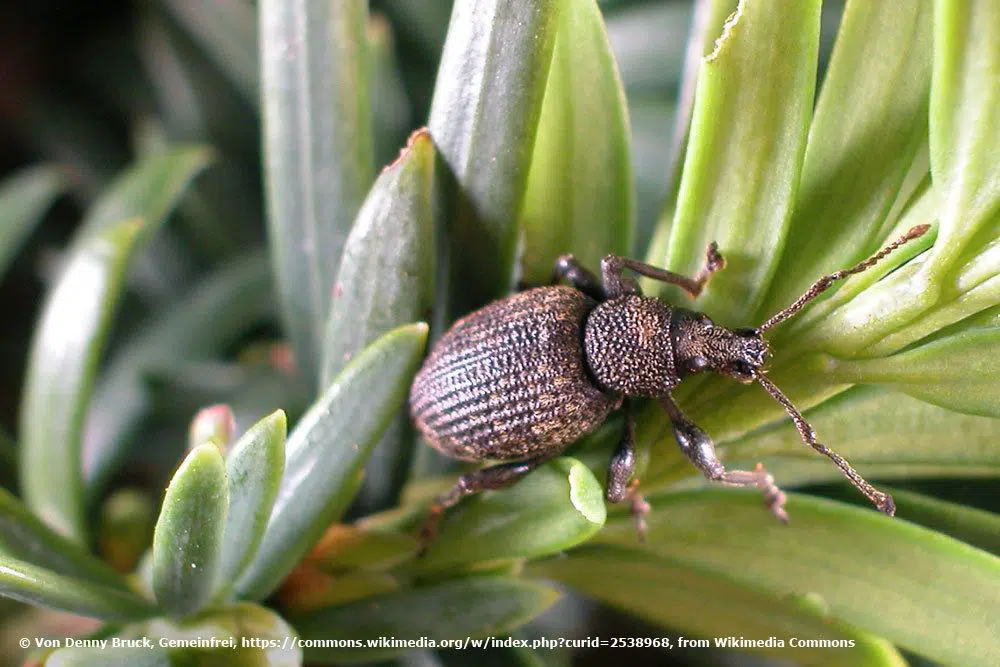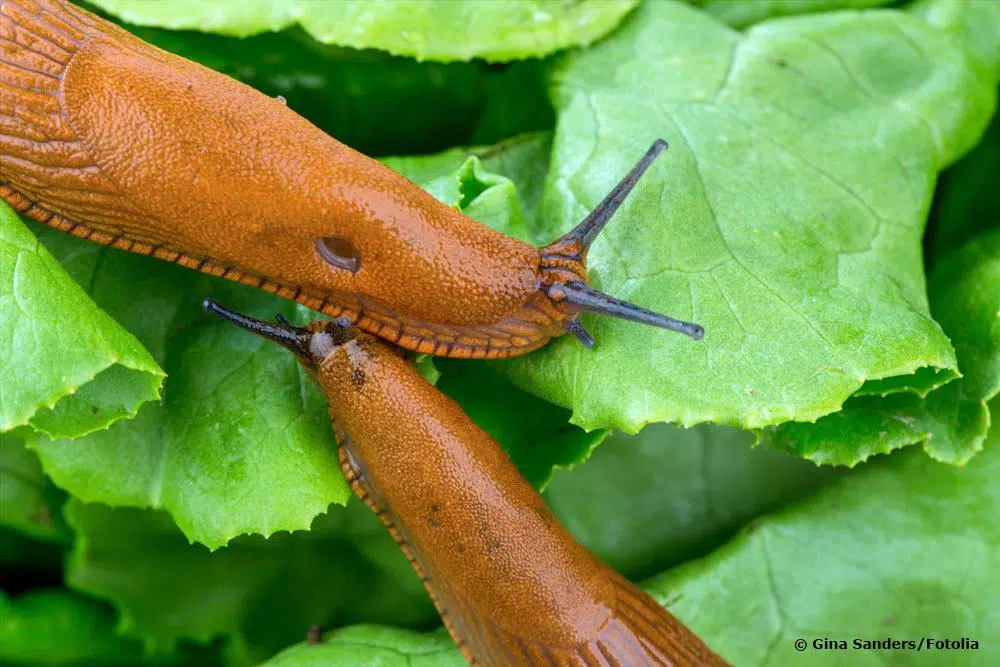Basil is widely used as a plant and kitchen herb, and is liked by some pests as well as people. If the leaves of basil are eaten, this is a clear indication of certain pests. Even some animals do not stop at Ocimum basilicum. In order to get rid of the uninvited guests and/or protect the basil from them, it is necessary to identify the “culprit” in advance.
Basil eaten
If you discover feeding marks on the leaves of aromatic basil, you are probably wondering who is behind it. There are several canditates that are responsible.
Contents
Snails
If leaves of basil are eaten, then in most cases snails (Gastropoda) have tampered with them. They sneak out of their winter quarters onto the plants in early spring, when temperatures are above the frost line. They usually start feeding in the evening and especially at night.
Appearance
- Elongated head with two antennae
- With snail shell: body rolls up in case of danger or in sleep mode
- Without snail shell: body rolls up in case of danger or in sleep mode
- between different black as well as brown, brown-yellowish and orange tones
- Move in waves
- Leave slimy trails
- between 2.5 centimeters and 15 centimeters (large slug (Arion ater))
Damage pattern
- Basil leaves eaten from the edge inwards
- Often holes in the middle of the leaf
- Rapid bare feeding
- Slime traces on plant and possibly the soil
Causes
They are almost attracted to basil and feel especially at home in herbaceous beds, because here they find an ideal food source, which is the only reason for feeding on Ocimum basilicum. At night temperatures around 20 °C and high humidity they are particularly eager to feed.
Control
For the control of snails, there are several methods to choose from, but not all of them are effective or work at all:
- Collect cold-starved snails early in the morning at lower temperatures.
- erect a snail fence as a barrier (also available as an electric fence)
- Set up beer traps
- Place sawdust a few inches high around the plant
- Spread dried coffee grounds around the basil
- Scented plants as neighbors, such as lavender or gypsophila
- Only resort to chemical poison traps if nothing else helps
Common earwig
The common earwig (Forficula auricularia) belongs to the flying insects and can be found more often on basil plants from the supermarket. It is an omnivore and leaves feeding marks on all parts of the basil plant, from the leaves to the flowers to the stems. If it is not stopped, it will eat the entire plant, but it takes a long time for it to do so. It is active at dusk.
Appearance
- Six legs
- Body length: ten to 16 millimeters
- Body color: dark reddish-brown, lateral thorax light brown
- Short stubby wings
- 15-limbed antennae
- Two pincers on the abdomen
- Light yellow-brown legs
- One or two small teeth on the inside of the abdominal appendages
Damage pattern
- Feeding marks first on leaves, then on flowers, later on stems
- Relatively small but numerous feeding marks
- Course quite slow
- Leaves lose stability
- Partially eaten roots, which subsequently look hollowed out
- Usually not a life-threatening situation for the plant
Cause
As a rule, earwigs only appear in the vicinity where there are aphids, on which they mainly feed. If the number of aphids decreases, earwigs will move to neighboring plants and feed on the plant foliage and flowers.
Control
To control earwigs, or earwigs as they are also called, help is not necessarily needed from chemical insecticides. More environmentally friendly are biological products and home remedies, as well as tricks for relocation. The latter is a smart solution, as earwigs are also beneficial insects.
- Surround basil with sticky glue rings.
- Spray affected plant with neem oil two to three times a week (drives them away)
- Use/attract natural predators such as shrews, spiders and toads
- Relocate by means of a pot
- Fill clay pot with straw or wood shavings
- Place next to basil (with slope so earwigs can get in easier)
- On the following day, pour out the pot in another place with earwigs
- Repeat the process as often as necessary
Thick-mouthed weevil
The thick-mouthed weevil (Otiorhynchus) is one of the most feared garden and herb pests, and is not deterred by the smell of basil. It is very active especially during warm summer days and remains so until temperatures drop in the fall. If it finds its way to warmer climes, such as a winter garden, it does not need to hibernate and continues its “mischief” there. It is crepuscular and nocturnal. During the day he then hides where it is dark – gladly under the basil pot.

Appearance
- Visually like a beetle
- Six legs
- Two antennae and between them thick proboscis
- Body color: shiny black/dark brown
- Body length: about one centimeter
- Oval body shape
- Light yellow scaly hairs and longitudinal grooves on the back
- Do not fly, but run fast
- Larvae creamy white, hatch between August and October
Damage pattern
- Semicircular feeding marks on leaf edges
- Brown coating at feeding sites
- Larvae gnaw roots, plant droops
- Flowers wither, buds remain closed or fall off
- Larvae debark roots
- In advanced stage hollowed out roots
- Plant rapidly decreases in vitality
- Without specific help, plant dies
Cause
Among its favorite foods are leaves, buds or young shoots. Always hungry, it goes in search of its favorite food, which includes basil. In addition, the females need a place where they can lay their eggs in a protected environment. Then, if peaty soil is present, the best conditions are created for dick weevils.
Control
If there is no egg-laying, so that only isolated thick weevils are present, in most cases the plant suffers no serious damage and control is not mandatory. However, since they often overwinter in the root area and the females can lay up to 1000 eggs, the risk of an “invasion” and the associated total damage to the plant, should be taken by control in any case.
Collecting
A small, dark animal is hardly recognizable at night, so that a collection is hardly possible. A container filled with wood wool placed directly next to the Ocimum basilicum can help. The procedure is as follows:
- Fill the pot with wood wool
- Place the pot with the opening downwards on newspaper or similar (directly next to the basil).
- Raise the side of the pot in the direction of the plant with one or two stones, so that pests can run into it
- Pests will use this as a sleeping place/hiding place during the day
- In the morning lift/ turn over newspaper with pot and dispose of bugs
- Repeat several times, as not all beetles will stay there right away
- Ideal time for collecting: between May and August
Tip: However, the beetles should never be disposed of in the compost or elsewhere, so that the pests cannot get back onto plants. Disposal should therefore always be made through the household waste.
Home remedy
Their appetite for the leaves and flowers can be taken away if a soft soap solution is applied. This will not harm the basil, but will drive thickmouth weevils away. Here’s how it’s done:
- Dissolve 150 to 300 grams of soft soap in ten 10 liters of hot water.
- Allow to cool
- Pour into a spray container
- Spray plant two to three times a week
- Carry out over a few weeks depending on the extent of the infestation
Also helps for prevention
Nematodes
Nematodes are tiny threadworms that are effective against larvae in the process. If these come into contact with the nematodes, then they become infected with mutating bacteria and die. The nematodes can be purchased at garden centers.
Leaf miner fly
The leaf miner fly (Agromyzidae) or its larvae often attack basil. However, a leaf miner infestation can be easily recognized by the damage pattern.
Appearance
- Larval size up to three millimeters, whitish-yellow color, typical fly maggot appearance
- Leaf miner size: one to two millimeters – gray-black ground color with yellow spots
- Occasionally cream-colored eggs can be seen on the underside of leaves
- puncture marks in the leaves (lay their eggs there)
Damage
- Yellowish discoloration around puncture sites
- Minimal pitting at the puncture sites (larvae eat their way out of the leaf interior)
- Yellow or brown lines on the leaves (they move through the interior of the leaf tissue via “miner tunnels”)
- Leaf tissue dies around the miner tunnels and dries out
- Drop of affected leaves
- Growth disturbances
- Young plants die quickly
Cause
In search of an ideal place to lay their eggs and at the same time a source of food, leaf miners often find their way to basil. Ideal conditions are given when compacted soil and/or a lack of supply weakens plants and when there is an even humidity.
Control
- Cut off and dispose of infested plant parts
- In case of heavy infestation, dispose of the basil completely
- Use of beneficial insects, such as ichneumon flies and ladybugs
- Nettle broth
- Chop up about one kilogram of fresh or dried nettles
- Pour over ten liters of cold water (nettles must be completely covered)
- Use bucket with lid/cover and place in direct sunlight
- Leave to infuse for between twelve and 24 hours, stirring several times in between.
- Afterwards sieve out stinging nettle residues
- Spray basil outdoors with broth several times a week (broth stinks)
Note: Only nettles that do not have flowers should be used for the decoction, as these have an influence on the effect.
Other animals
Cats
The cat is not an avid green plant eater and is especially not attracted to the essential oils of basil, but still curiosity as well as its urge to play can make it eat basil leaves. However, Ocimum basilicum is not poisonous to them. Only a very young animal can react to the basil leaf feeding, which then becomes noticeable by slight stomach and intestinal problems. To avoid leaf feeding, some tricks help to keep cats at a distance:
- Sprinkle pepper
- Delimit with rabbit fence
- Plant cat grass next to it (cats prefer)
Mice and rats
Mice and rats love basil, which is even offered in dried form as a feed (additive) in pet specialty stores. For herb bed owners, however, this is not pleasing, because eaten leaves of basil should not be consumed, because may well be transmitted diseases. Apart from setting up classic mice and rat traps, however, amateur gardeners and herb lovers don’t have much else to do to solve the problem. However, it is worth a try to keep them at bay with scents of garlic, savory, cucumber herb and/ or thyme.


